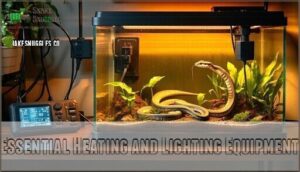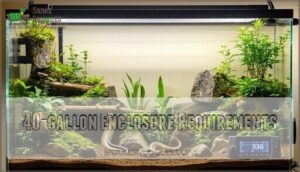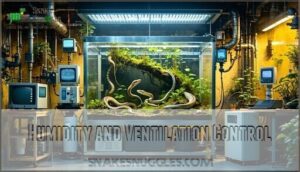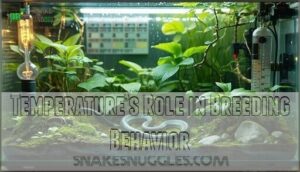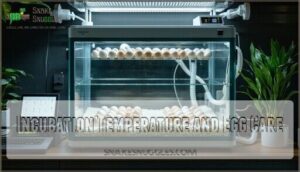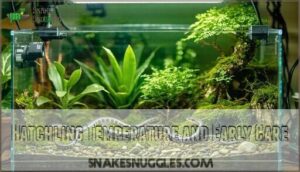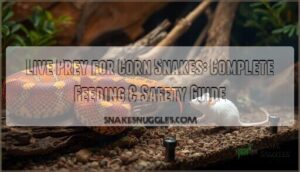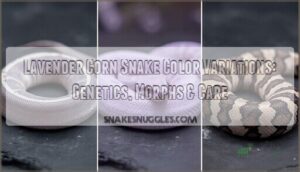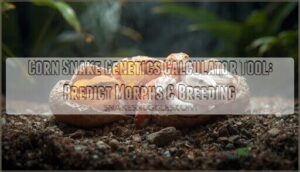This site is supported by our readers. We may earn a commission, at no cost to you, if you purchase through links.
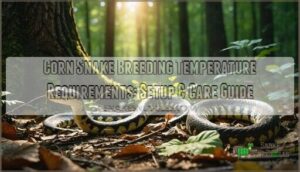
While many keepers obsess over incubation temps, the real pivotal moment happens weeks earlier. Your breeding pair needs precise thermal zones that mirror the seasonal shifts they’d experience in North Carolina hardwood forests—not the static heat of a typical pet setup.
Getting these corn snake breeding temperature requirements right means understanding that successful reproduction isn’t about keeping snakes warm; it’s about orchestrating a carefully timed thermal dance that awakens their reproductive biology. Master the temperature protocols from pre-breeding conditioning through hatchling care, and you’ll transform those genetic pairings into thriving offspring.
Table Of Contents
- Key Takeaways
- Optimal Breeding Temperatures for Corn Snakes
- Essential Heating and Lighting Equipment
- Setting Up The Breeding Enclosure
- Preparing Corn Snakes for Breeding
- Temperature’s Role in Breeding Behavior
- Incubation Temperature and Egg Care
- Hatchling Temperature and Early Care
- Frequently Asked Questions (FAQs)
- Conclusion
Key Takeaways
- Successful corn snake breeding hinges on precise temperature management throughout the entire reproductive cycle, particularly during the pre-breeding conditioning period where a gradual 8-12 week cooling phase at 50-60°F triggers the hormonal responses necessary for mating behavior.
- Creating proper thermal gradients (85°F warm side, 75°F cool side) with nighttime drops to 70°F allows breeding pairs to thermoregulate naturally, while incubation requires strict maintenance at 78-84°F with 80-90% humidity to prevent egg failure.
- Breeding readiness depends on physical maturity rather than just age—following the "3-3-3 rule" (3 years old, 3 feet long, 300 grams) prevents reproductive complications and increases clutch success rates above 80%.
- Equipment precision matters more than genetics, requiring digital thermostats, UVB lighting cycles (10-12 hours daily), and backup power systems to maintain the stable thermal environment that separates consistent breeding success from failed clutches.
Optimal Breeding Temperatures for Corn Snakes
Getting your corn snake breeding temperatures right isn’t just about keeping the lights on—it’s about recreating the environmental cues that trigger mating behavior.
Your breeding enclosure needs precise thermal zones that mirror what these snakes experience in their natural habitat.
Let’s break down the three critical temperature considerations that’ll set you up for breeding success.
Warm and Cool Side Gradients
Creating the right temperature gradient in your corn snake’s enclosure isn’t just recommended—it’s the cornerstone of successful breeding and healthy reproductive behavior.
You’ll need to establish a warm basking temperature of 85°F on one side and a cool zone of 75°F on the other, giving your snakes proper climate zones for thermoregulation.
This gradient management allows your breeding pairs to move between heating and humidity control areas as their bodies demand, supporting natural thermal cycling essential for reproductive success.
Nighttime Temperature Adjustments
Once you’ve dialed in those daytime zones, you’ll want to drop the entire enclosure to around 70‐°F at night—mimicking the natural temperature dip your corn snakes would experience in the wild. This nighttime gradient promotes healthy thermal cycles and reduces stress during breeding season. Here’s how to maintain proper ambient control:
- Reduce heat sources gradually using programmable thermostats for smooth temperature fluctuations
- Monitor cooling methods to prevent sudden drops that disrupt thermal environment stability
- Maintain consistent nighttime gradients across all breeding enclosures for synchronized reproductive behavior
- Check temperature control equipment nightly to guarantee reliable heating and humidity control systems
Seasonal Cycling and Temperature Shifts
Your breeding snakes won’t cycle properly without temperature fluctuations that mirror their natural habitat. Start with a gradual cooling phase—drop ambient temps by 10–15°F over several days to trigger seasonal triggers, then maintain brumation at 50–60°F for 8–12 weeks.
This cold period sparks hormonal responses tied to gonadal development and breeding readiness. When you raise temperatures back to your standard thermal gradient with basking spots at 88–90°F, you’ll synchronize mating cycles and boost breeding corn snakes success rates above 80%.
Maintaining the essential temperature control systems is vital for the health and breeding success of your corn snakes.
Essential Heating and Lighting Equipment
Getting your breeding setup right starts with the right equipment—because guessing games don’t work when you’re managing delicate temperature ranges.
Your corn snakes need reliable heating, proper lighting, and fail-safe backup systems to thrive through breeding season.
Let’s break down the three essential categories of equipment you’ll need in your arsenal.
Thermostats and Under-tank Heaters
You can’t risk temperature swings when you’re managing breeding cycles, so a quality thermostat paired with under-tank heaters becomes your first line of defense against failed clutches and stressed snakes.
Position your heating elements along one side of the enclosure to create a proper temperature gradient, then dial your thermostat settings to maintain that essential 85°F basking temperature on the warm end while allowing natural thermoregulation throughout the tank.
UVB Lighting Benefits and Cycles
While many breeders skip UVB lighting for corn snakes, studies show significant health advantages when you provide proper UVB spectrum exposure—plasma vitamin D3 levels nearly tripled in snakes with UVB access compared to controls, supporting calcium metabolism and immune function. Understanding UVB lighting needs is vital for creating an environment that fosters the health and well-being of your corn snakes.
Set up your lighting cycles to match natural photoperiod effects:
- Install T5 HO 5.0 bulbs positioned 10-15 inches above basking zones to deliver safe UVI levels between 2.0-3.0 for ideal thermoregulation
- Run a 10-12 hour daily cycle that mimics spring and summer daylight, promoting reptile health through consistent vitamin D3 synthesis
- Replace bulbs every 12 months even when they still glow, since UVB output degrades long before visible light dims
Temperature control matters, but adding reptile lighting creates measurable improvements in growth rates and disease resistance throughout your breeding program.
Power Backup Solutions for Enclosures
Power outages during critical incubation windows can destroy an entire clutch within hours, which makes reliable backup systems one of your most important investments before you ever introduce breeding pairs.
Install uninterruptible power supply units rated for at least 1500VA to maintain your temperature control equipment—pair them with surge protectors and emergency lighting so you can monitor your breeding setup during outages.
For extended power loss, portable generators preserve the thermal environment and temperature gradient your incubation equipment depends on.
Setting Up The Breeding Enclosure
Setting up your breeding enclosure correctly from the start saves you headaches down the road. Your corn snakes need specific space, substrate, and environmental controls to breed successfully.
Let’s break down the three essential components that create a proper breeding environment.
40. gallon Enclosure Requirements
A 40-gallon terrarium isn’t just a recommendation for breeding corn snakes—it’s the minimum footprint your breeding pair needs to establish separate thermal zones, reduce stress, and support the physiological demands of reproduction.
You’ll want floor space measuring at least 36 inches long by 18 inches wide, which allows proper temperature control and humidity levels throughout your breeding setup.
Adequate enclosure size directly affects snake comfort and ventilation systems, ensuring your corn snake temperature requirements support successful reproduction without cramping essential equipment costs or space planning for incubation equipment.
Substrate and Hide Box Selection
Choosing the right substrate and hide boxes creates the foundation—literally—for maintaining proper thermal gradients and giving your breeding pair the security they need to cycle into reproductive mode.
You’ll want cypress mulch or aspen shavings for substrate options that hold humidity without molding, paired with at least two hide boxes per snake—one on the warm side, one on the cool. Proper hide box placement facilitates temperature control while reducing stress that can derail your entire breeding setup.
Humidity and Ventilation Control
Balancing humidity and ventilation is like walking a tightrope—you need enough moisture to support healthy shedding and egg development, but too much stagnant air invites respiratory infections and bacterial growth that can wipe out your breeding season.
Install ventilation design features that allow Air Flow Systems to circulate without creating drafts, and use Humidity Sensors to track Moisture Control in real time.
You’ll maintain humidity levels between 50-60% for adults while ensuring Breathing Spaces prevent stagnation, which keeps your temperature control and incubation equipment functioning optimally throughout the breeding cycle.
Preparing Corn Snakes for Breeding
Before you bring your corn snakes together, you need to make sure they’re actually ready for the job. Getting this prep work right isn’t just about hitting the right temps—it’s about ensuring your snakes are mature enough, healthy enough, and physically prepared for the demands of breeding.
Here’s what you need to check off your list.
Age and Maturity Guidelines
Your corn snakes aren’t ready to breed just because they’ve hit their first birthday. Breeding Readiness depends on both age and size—most experts follow the 3-3-3 rule: 3 years old, 3 feet long, and 300 grams in weight.
While sexual maturity starts around 18 months under ideal conditions, rushing the process risks stunted growth and smaller clutches. Size Requirements matter just as much as Age Factors, since undersized females face higher mortality rates during egg-laying.
Health Checks and Quarantine Protocols
Before you pair up your snakes, you’ll need to confirm they’re disease-free and properly quarantined—skipping this step can wipe out your entire breeding operation overnight.
Implement these quarantine protocols for snake health:
- Isolate new snakes for 90 days minimum in separate enclosures to prevent disease transmission
- Schedule veterinary care for health screening, including fecal exams and genetic testing if breeding for specific morphs
- Monitor daily for respiratory infections, mites, or abnormal behavior that signals underlying animal health issues
Reptile breeding success hinges on these quarantine methods—one sick snake can devastate months of careful preparation.
Weight Management and Pre-breeding Care
Your breeding snakes won’t produce healthy clutches if they’re underweight or carrying excess fat—getting this balance right makes or breaks your season. Feed females every 5-7 days for steady weight gain before the pre-breeding cooldown, targeting a body condition where ribs aren’t visible but aren’t buried in fat.
Breeding success hinges on maintaining proper body weight—females need steady pre-cooldown gains without visible ribs or excess fat
Snake nutrition directly impacts egg production, so conduct health checks monthly alongside proper temperature control and humidity levels in your breeding setup—genetic diversity means nothing if your snakes can’t physically manage reproduction.
Temperature’s Role in Breeding Behavior
Temperature doesn’t just keep your corn snakes comfortable—it’s the switch that flips their breeding instincts into gear. Getting the thermal environment right means understanding how seasonal shifts, day-to-day gradients, and targeted cooling periods work together to trigger mating behavior.
Let’s break down the three key ways temperature influences your breeding success.
Environmental Triggers for Mating
Think of mating triggers as nature’s carefully timed alarm clock—your corn snakes won’t breed without the right environmental cues. After a 60–90 day winter cooling process at 10–16°C, gradual warming to 28–30°C kickstarts the breeding cycle through pheromone signals and increased activity.
You’ll need to pair this temperature control with longer photoperiod effects (14–16 hours of light) to mimic seasonal cues. This environmental manipulation replicates what happens in the wild during March through May, when brumation periods end and the thermal environment shifts.
Without proper temperature shifts and these natural triggers, even healthy snakes won’t show breeding behavior.
Impact of Thermal Gradients on Activity
Once your snakes respond to those environmental cues, the thermal gradient you’ve set up becomes the stage where all their daily activity plays out. Your corn snakes use this temperature gradient for critical thermoregulation, moving between warm and cool zones to regulate:
- Digestion and metabolic processes
- Immune system function
- Reproductive hormone production
- Energy conservation during rest periods
- Hunting and exploratory behavior
Without proper basking temperature options (85°F warm side, 75°F cool side), you’ll see sluggish snake behavior and reduced breeding success.
Mimicking Natural Seasonal Changes
To truly achieve breeding success, you need to mirror the seasonal rhythms that wild corn snakes experience throughout the year. This involves implementing a winter cooling process, where you gradually reduce the temperature range from 85°F to 50-55°F over several weeks.
These thermal cycles and seasonal shifts trigger natural reproductive hormones—fundamentally, you’re using environmental manipulation to flip their biological breeding switch.
Adjust natural light exposure alongside these temperature fluctuations, creating the environmental triggers that prime your snakes for successful mating and ideal incubation temperature outcomes.
Incubation Temperature and Egg Care
Once your corn snake eggs arrive, maintaining precise incubation conditions becomes your top priority. Temperature and humidity must stay within narrow ranges, and you’ll need to monitor the eggs regularly without disturbing their development.
Let’s break down the three essential aspects of successful egg incubation.
Maintaining Optimal Incubation Range
Precise thermal control during incubation separates successful hatches from failures. You’ll want to maintain a steady temperature range between 78–84°F, with 82°F being the ideal spot for peak egg development and breeding success.
Digital probe thermometers give you the accuracy needed for consistent thermal control, and checking readings twice daily prevents dangerous drift. Calibrate your incubator before placing eggs inside, and consider alarm systems to protect against overheating—because at this stage, even small temperature fluctuations can compromise hatchling care outcomes and overall incubation success.
Humidity Control for Egg Development
Humidity levels during incubation aren’t just important—they’re the difference between healthy hatchlings and eggs that collapse or drown. You’ll need to maintain 80–90% humidity throughout egg incubation, using vermiculite or perlite substrates that hold moisture without drowning eggs.
Check humidity levels with a reliable hygrometer twice daily, and adjust your egg laying environment by misting or adding water to the incubation medium. Proper humidity levels management directly impacts breeding success and ensures ideal hatchling care from the start.
Egg Monitoring and Rotation Practices
Watching your eggs like a hawk might sound excessive, but missing subtle warning signs—like mold, dimpling, or fungal growth—can cost you an entire clutch in just 24 hours.
You’ll want to inspect eggs daily using egg candling techniques to check embryo development without rotating them—corn snake eggs shouldn’t be turned once positioned.
Monitor incubation temperature and humidity levels closely, marking each egg’s orientation with a pencil to prevent accidental rotation during routine checks for successful hatchling care.
Hatchling Temperature and Early Care
Once your hatchlings emerge, they’ll need their own carefully controlled environment to thrive. The shift from egg to independent snake is delicate, and getting the temperature and humidity right from day one sets the foundation for healthy growth.
Let’s look at the three essential elements you’ll need to master for successful hatchling care.
Neonate Enclosure Setup
Hatchlings start life in a vulnerable state, so setting up their first home correctly isn’t just important—it’s the difference between thriving neonates and struggling snakes.
You’ll need small enclosures like 6-quart plastic tubs with secure ventilation holes drilled along the sides. Line the bottom with paper towels for easy cleaning and monitoring, add a water dish, and include a small hide box.
This neonate housing simplifies hatchling care while giving you complete control over humidity levels and temperature within your breeding setup.
Temperature and Humidity for Hatchlings
Getting the temperature and humidity dialed in for your hatchlings isn’t guesswork—it’s the foundation that determines whether they’ll shed cleanly, feed reliably, and grow into healthy adults.
Maintain juvenile temperature at 80-82°F on the warm side with a cooler retreat around 75°F, allowing proper hatchling thermoregulation.
Neonate humidity should stay between 60-70%, higher than adults but lower than egg incubation levels, supporting environmental acclimation without risking respiratory issues during critical reptile care phases.
Feeding and Health Monitoring
A well-fed hatchling with stable vitals will outpace every genetic advantage you carefully planned for, so tracking meals and body condition from day one separates breeders who hope from those who consistently produce thriving snakes.
Offer pinky mice every five to seven days, adjusting feeding strategies based on individual snake nutrition needs and refusal patterns.
Weigh your hatchlings weekly and watch for signs requiring veterinary care—kinked tails, labored breathing, or repeated regurgitation signal disease prevention failures that demand immediate animal health and wellness intervention during critical reptile care phases.
Frequently Asked Questions (FAQs)
How do temperature fluctuations affect breeding success rates?
Temperature control directly influences breeding cycles and snake behavior. Inconsistent thermal environments disrupt hormonal triggers, reducing mating activity and egg incubation success.
Your breeding setup must maintain precise temperature ranges to support reproductive readiness and hatchling viability.
What temperatures trigger brumation in corn snakes?
Brumation triggers kick in when you gradually lower nighttime temperatures to 50-55°F over two weeks—this cold shock mimics natural seasonal cues.
Maintain this temperature range for 8-12 weeks to induce proper dormancy, which markedly boosts breeding success rates by up to 70%.
Do different morphs require specific temperature ranges?
No, different morphs don’t require specific temperature ranges. All corn snake color genetics respond identically to thermal conditions.
Breeding variations stem from morph selection and genetic diversity, not thermal adaptation. Temperature influences breeding success universally across snake morphology.
How quickly should post-brumation temperatures be increased?
Like easing into a warm bath, post-brumation temperature increases should be gradual—raising your thermal environment by 5°F every three to four days until you’ve restored the full temperature gradient.
This thermal acclimation period aids brumation recovery and prevents shocking your breeding corn snakes during the warming up phase, ensuring smooth post brumation care as their bodies adjust from the winter cooling process.
Conclusion
Like a conductor tuning an orchestra before the first note, your mastery of corn snake breeding temperature requirements determines whether genetics translate into living hatchlings or disappointment.
Every degree during brumation, every gradient in your breeding enclosure, and every incubation adjustment compounds into reproductive success or failure. The thermometer doesn’t lie—your snakes respond to thermal precision, not good intentions.
Implement these protocols exactly, monitor relentlessly, and you’ll consistently produce healthy clutches that validate your investment in controlled environmental breeding.
- https://www.semanticscholar.org/paper/Does-exposure-to-UVB-light-influence-the-growth-and-Palmer/0014580c213ab41081af864d56ed6bae3332c81d
- http://www.lightyourreptiles.com/arcadia-d3-t-5-22-inch-24-watt-6-forest-uvb/
- https://www.reptilebasics.com/t5-light-fixtures/shadedweller-max/
- https://reptifiles.com/corn-snake-care-guide/corn-snake-temperatures-humidity/
- https://zoologicalstudies.springeropen.com/articles/10.1186/1810-522X-52-33

